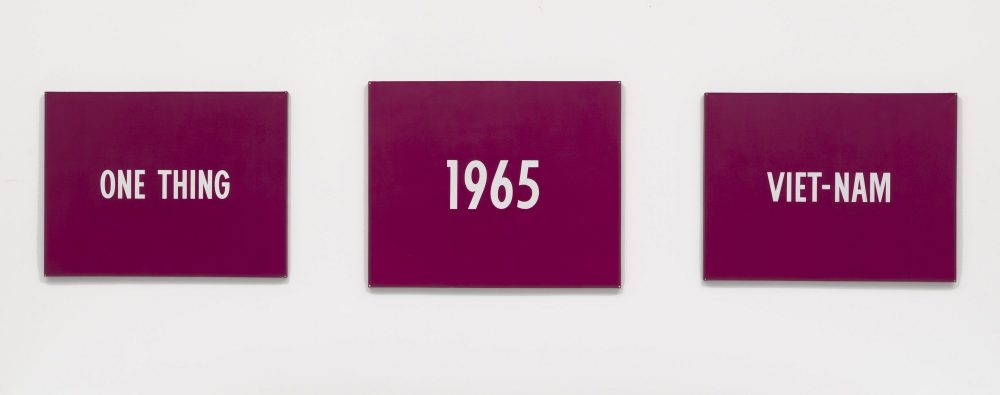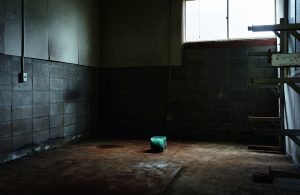On the third floor of the Smithsonian American Art Museum, the elevator door opens to face three four-foot tall canvases painted a deep, glowing red. In bold white font, they read: “ONE THING,” “1965,” and “VIET-NAM.” The starkness of the piece conveys a sense of violence. This is how Artists Respond: American Art and the Vietnam War, 1965-1975 begins—with a jolt.
The floor consists of five galleries connected by a single hallway. True to its title, Artists Respond, every single work in this exhibition presents a commentary on the Vietnam War. Within this overarching topic, the art is organized by theme, creating a comprehensive narrative that details commonalities in the artists’ perspectives and uses of genre. These works express individual narratives and ask the viewers questions to which they are not supposed to know the answer.
The first gallery, “Living Room War,” focuses on the significance of the Vietnam War as the first widely televised, real-time military conflict. Specifically, Martha Rosler’s “House Beautiful: Bringing the War Home” (1967-72) series fascinatingly explores the idea of bringing the violence of the Vietnam War into the comfort and safety of American households. One of the most powerful images from this series is titled “Pat Nixon.” The First Lady stands in an elegant, golden outfit amidst matching decor, presumably inside the White House. The only area without a warm hue is the small picture in an oval frame above her head, a photograph of a Vietnamese woman contorted in pain, bloodstains spotting her dress. This abnormality does not reveal itself immediately, but once noticed, it becomes the absolute focus of the piece, creating a striking juxtaposition of Nixon in domesticity among the violence her husband perpetuated.
The idea of a “living room war” is further illustrated by Edward Kienholz’s tableau, “The Eleventh Hour Final” (1968). To see the most immersive piece in the entire exhibition, viewers step into a side room of the gallery, decorated like a typical American, middle-class, suburban living room—down to a TV guide and an ashtray full of cigarette butts on the coffee table. Only once the viewer turns around do they see the subject within the faintly illuminated TV itself: a sculpted severed head lying on the bottom of the television set with the weekly death toll of American and Vietnamese lives painted on the glass screen in front of it. The piece resembles a fishbowl, highlighting both the scene’s violent transparency and the degree of separation between the viewer and subject.
The third gallery, “Shoot, Burn, Resist: The Body,” is the most unique, focusing strictly on performance art. In many of these pieces, artists use their bodies as mediums by actively inviting violence to be inflicted on them. “Reading Position for Second Degree Burn” (1970) shows one photo of Dennis Oppenheim lying on the sand at Jones Beach with a volume of military field tactics across his chest. A second photo, taken five hours later, shows the white rectangle left on his chest surrounded by a red sunburn. This photo set symbolizes the imprint of violence left by the Vietnam War and specifically protests the use of napalm—hence the imagery of painful burns.
An interesting yet understated depiction of violence on the body in performance art is Yoko Ono’s “Cut Piece” (1965). Presented as a black and white video, the work shows Ono’s interactive, artistic experiment in which she sits on the stage of Carnegie Hall and invites audience members to come and use a pair of scissors to cut a piece of her suit. Even as Ono tries to look stoically ahead, her face betrays a sense of discomfort as her clothes are stripped away. Eventually, she is left holding up the cups of her bra in front of the audience; her entire suit has been cut away, and the straps of her bra have been snapped. The piece presents each audience member with the choice to participate and escalate the situation. Each individual choice contributes to Oko’s eventual discomfort and vulnerability, similar to the process behind the gradual—and then rapid—progress of U.S. involvement in Vietnam.
The fourth gallery, “Selective Service,” focuses on pieces of art protesting the draft. This room features the work of many African-American and Chicano artists, who represent communities disproportionately affected by mandatory conscription. These pieces raise awareness of the violence specifically inflicted on these communities by the draft, as well as the role that money and race played in determining who got sent overseas to fight—and die—for this country. In “America the Beautiful” (1968), David Hammons, an African-American artist, uses his arms to spread black grease stains on a canvas, vaguely creating the features of a ghostly figure with a much clearer, brightly colored American flag draped over it. This contrast highlights the identity of the individual versus the burden placed on him or her by unjust national policies.
The fifth and final gallery is the largest, encompassing “A War of Information,” “Homecoming,” and “Prints for Peace.” The vast range of themes and works that this gallery houses minimizes the significance of many of its pieces, especially those that are smaller in scale. The gallery shines, however, in its statement pieces that utilize the given space. Two of these are Hans Haacke’s “News” (1969, reconstructed 2019) and Jesse Treviño’s “Mi Vida” (1971-73). The former consists of a roll of paper being fed through a teletype machine that continuously types out the news of the day from different sources. Chaos ensues as the continuous roll of paper forms a six-foot-long pile on the floor with only certain bits discernable, rendering the information meaningless. The latter piece, a 20-foot tall acrylic painting, makes great use of the gallery’s larger space by depicting the artist’s current habits and former haunts as an infantryman in Vietnam.
While almost all of them present the war in a negative light, one cannot merely say that these are five galleries full of protest art. Instead, each piece brings the pain, frustration, and confusion of the artists’ unique perspectives directly to the viewer. Although its subject is 50 years old, the exhibit is still a powerful experience for modern audiences.
Image: On Kawara, Title, 1965, acrylic and collage on canvas, National Gallery of Art, Washington, Patrons’Permanent Fund. © One Million Years Foundation, Photo courtesy One Million Years Foundation and David Zwirner





